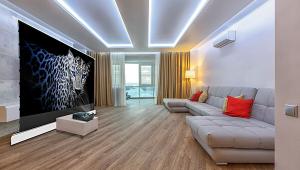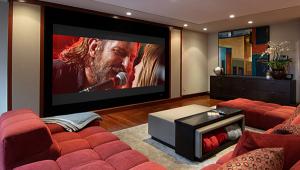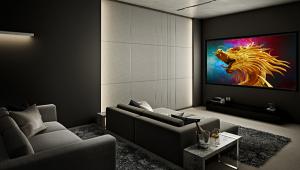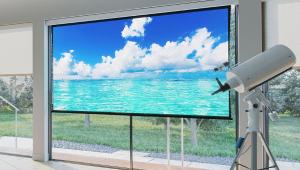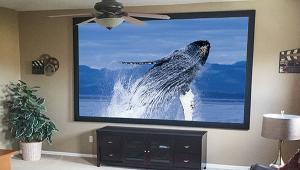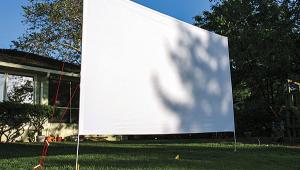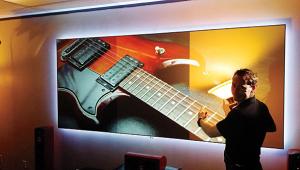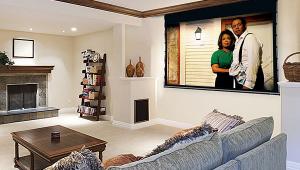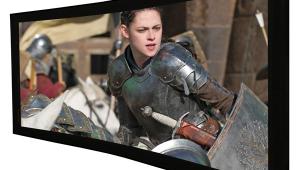It would be great if you could do a comparison of the Acoustic Transparent Screen vs Non AT of the same model. Perhaps a 2 parts series; part 1 with emphasis on video, part 2 with audio.
I am in the process of building a dark cave. The StudioTek 130 G3 AT screen cost twice as much as non AT screen. Does AT have twice the quality as Non AT?
Stewart Filmscreen StudioTek 100 Screen Page 2
Less Is More
When I asked Stewart about doing this review, I requested a large sample piece of StudioTek 100 material that I could use to test directly against my existing StudioTek 130. Since my screen
is a 10-foot-diagonal wall-mounted model, it would be impossible for me to compare it directly with another wall-mounted screen. By using a larger than normal swatch of StudioTek 100 material, I was able to put it right up against my existing material and compare the two directly with a wide range
of content. After my comparisons proved promising, I replaced the StudioTek 130 material in my existing frame with the new material and spent some time living with it on a day-to-day basis.
The comparisons turned out to be a lot of fun. They also revealed some interesting artifacts that almost need to be seen to be understood, though I’ll do my best to explain them. As mentioned before, I could see fine texture in very bright areas of the image with the StudioTek 130 screen if I went looking for them. Casual viewing was never an issue, but once I was aware of an artifact, I would see it off and on—especially with animation, which tends to have brighter images with large patches of pure white.
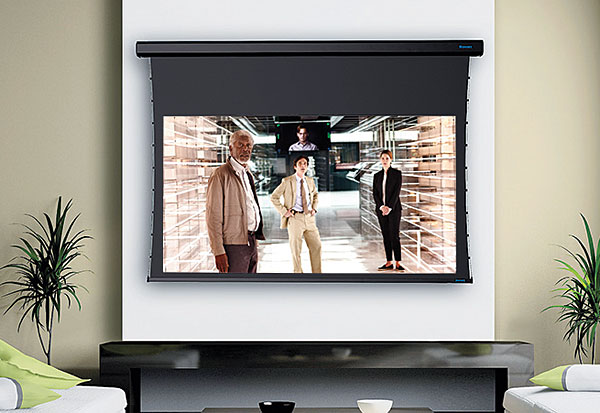
When I compared the two screen materials directly, the benefits of the StudioTek 100 material were obvious. I saw almost no texture at all. In fact, the image was so improved that I needed to move a lot closer to the screen to see even the slightest amount of texture. A great clip for showing the benefits of this was the entire opening sequence of The Art of Flight, an extreme snowboarding movie produced by Red Bull. On Blu-ray, it’s a great demo piece for both audio and video, and it showcases massive mountain ranges of pure white snow. The StudioTek 100 didn’t add the slightest hint of artifacts to the bright white powder of the mountain, whereas the StudioTek 130 had some perceivable texturing that was pretty easy to see with any type of movement or panning.
There was another, more unusual artifact I noticed. It almost looked digital in nature and a product of both the light from the projector coming off the screen and its reaction with my eyes. The closest thing I can compare it to is an artifact I see on my iPhone from time to time. If you’ve ever used your phone when your fingers were slightly oily, you may have left a bit of a smear on the display. If you look at that smear with a brighter image behind it, there’s a texture that almost seems to be a digital interference pattern of sorts. It also gives the display a slightly pixellated appearance. I was seeing this exact same artifact on both screens with pure white test patterns, but the intensity of it on the StudioTek 130 was far greater than on the StudioTek 100. The reduction of this effect with the StudioTek 100 made more difference in pure white areas of the image than even the lack of texture did!
After those comparisons, I installed the full-size material (120 inches diagonal) in my existing frame. Stewart screens are fairly easy to install, using a snap system that stretches the material tightly and fastens it to the frame. I wish that rehanging the frame were a bit easier, but with the help of a friend, we got it done in a reasonable amount of time. (My 120-inch-diagonal evaluation screen, with a Luxus Deluxe Quick Snap fixed frame, goes for $3,097; similar setups in smaller or larger stock sizes range from $2,170 to $3,178. However, this material is available in a wide range of other frames, including retractable and/or with masking.) After that, I did a full calibration of my reference JVC DLA-X700 DILA projector using a Klein K-10A tristimulus colorimeter profiled to a Jeti Specbos spectroradiometer and my reference Lumagen Radiance 2041 video processor. I had to redo a few settings in my JVC projector to achieve my standard 14 foot-lamberts of peak brightness, but this only required opening up the lens iris a couple more clicks than before. I could still use the JVC’s low lamp setting to achieve my desired brightness.
During my time with the StudioTek 100, I viewed a large amount of 1080p and 2160p (UHD) content. This was with both my reference JVC projector and the flagship VPL-VW1100ES from Sony that I had in for review. I was absolutely blown away by how good the StudioTek 100 looked with these projectors. Gone were even the slightest signs of artifacts in the brightest areas of the image, and the edge-to-edge uniformity in both white and color was staggering. I truly felt that I was seeing the best of what these projectors were capable of, without any flavoring added by the screen material. Keep in mind that the StudioTek 130 has long been considered to be one of the reference standards for video playback. While the difference between them can be pretty obvious when you know exactly what to look for or when you compare the two screens side by side, the StudioTek 130 still did a tremendous job. This is more of a fine-tuning difference that the most discriminating videophile would strive for.
My New Reference Standard
At this point, despite my high regard for the StudioTek 130, there’s no way I could go back to it. Since I’m lucky enough that my room environment is perfect for the StudioTek 100 and my projector is bright enough that I can still achieve the brightness levels I want, the StudioTek 100 will remain in my frame. This isn’t a screen for everyone, and I don’t know whether I’d recommend that current StudioTek 130 users rush out and replace theirs with it. But if you’re a discerning type who has noticed the slight texturing of your screen and found it intrusive, you may want to consider it. If you’re in the market for a new screen and this is one that your system and room/bat cave can support, I wouldn’t hesitate to put it at the top of your list.
Note: The Where to Buy link below is an affiliate link. If you purchase through the link, we may earn a small commission at no extra cost to you. Thank you for your support!
- Log in or register to post comments


Great review on a screen I have been heavily considering over that last month. Any chance you have been able to review the Elunevision Reference Studio 4k 100 screen that is said to be the same performance?

I can say that I have seen and tested samples of both the Stewart ST100 & Elunevision Reference Studio 4K 100 and I use the same pj as Kris (JVC X700R). The ST100 is much more transparent and artifact free to my eyes. If you look closely at each sample, the EV100 has much more texture to the material itself.
If I had a batcave, the ST100 would be my screen, but my setup requires ambient light rejection so I went with DNP Supernova, which is the best ambient light rejecting grey screen that I tested.

Thanks for posting this review Kris. I've told quite a few folks on the forums exactly what you found, but I'm not a reputable reviewer with fancy test equipment so my word was taken with a grain of salt I'm afraid. Hopefully this will aid people in making more informed purchasing decisions. It is true that you need a bat cave to get the best picture this screen can offer, but that's true with any front-projection setup. A projector can't project black, so the blacker the room, the higher the contrast is going to be. Some screens can enhance brightness and black levels, but this always comes with trade-offs in the form of aberrations/artifacts (sparkles, sheen, graininess, etc...).
Out of all the screen samples I have tested from various manufacturers, the only screens I would personally use are the Stewart ST100 & DNP Supernova materials.
